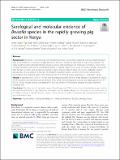| dc.contributor.author | James Akoko, Roger Pelle, Velma Kivali, Esther Schelling, Gabriel Shirima, Eunice M Machuka, Coletha Mathew, Eric M Fèvre, Victoria Kyallo, Laura C Falzon, AbdulHamid S Lukambagire, Jo EB Halliday, Bassirou Bonfoh, Rudovick Kazwala, Collins Ouma | |
| dc.date.accessioned | 2020-07-16T12:06:25Z | |
| dc.date.available | 2020-07-16T12:06:25Z | |
| dc.date.issued | 2020 | |
| dc.identifier.uri | https://repository.maseno.ac.ke/handle/123456789/1509 | |
| dc.description | Brucellosis is an emerging yet neglected zoonosis that has been reported in Kenya. Epidemiological data on brucellosis in ruminants is readily accessible; however, reports on brucellosis in pigs remain limited. This study sought to detect Brucella infection in pig serum by both serological and molecular techniques. Serum from 700 pigs randomly collected at a centralized abattoir in Nairobi region, Kenya were screened in parallel, using both Rose Bengal Test (RBT) and competitive Enzyme-Linked Immuno-sorbent Assay (cELISA) for antibodies against Brucella spp. All sera positive by RBT and 16 randomly selected negative samples were further tested using conventional PCR targeting bcsp31 gene and real-time PCR (RT-PCR) assays targeting IS711 and bcsp31 genes.
Results
A prevalence of 0.57% (n = 4/700) was estimated using RBT; none of these samples was positive on cELISA. All RBT … | en_US |
| dc.description.abstract | Abstract
Background: Brucellosis is an emerging yet neglected zoonosis that has been reported in Kenya. Epidemiological
data on brucellosis in ruminants is readily accessible; however, reports on brucellosis in pigs remain limited. This
study sought to detect Brucella infection in pig serum by both serological and molecular techniques. Serum from
700 pigs randomly collected at a centralized abattoir in Nairobi region, Kenya were screened in parallel, using both
Rose Bengal Test (RBT) and competitive Enzyme-Linked Immuno-sorbent Assay (cELISA) for antibodies against
Brucella spp. All sera positive by RBT and 16 randomly selected negative samples were further tested using
conventional PCR targeting bcsp31 gene and real-time PCR (RT-PCR) assays targeting IS711 and bcsp31 genes.
Results: A prevalence of 0.57% (n = 4/700) was estimated using RBT; none of these samples was positive on cELISA.
All RBT positive sera were also positive by both PCRs, while two sero-negative samples also tested positive on RTPCR (n = 6/20). Brucella abortus was detected in four out of the six PCR positive samples through a real-time
multiplex PCR.
Conclusion: The detection of antibodies against Brucella spp. and DNA in serum from slaughterhouse pigs confirm
the presence of Brucella in pigs. Therefore, investigation of the epidemiology and role of pigs in the transmission of
brucellosis in Kenya is needed. Further targeted studies would be useful to systematically quantify and identify the
spp. of Brucella in pigs.
Keywords: “Pig brucellosis”, “Molecular detection”, “Molecular evidence”, Brucella, Serology, Kenya | en_US |
| dc.subject | “Pig brucellosis”, “Molecular detection”, “Molecular evidence”, Brucella, Serology, Kenya | en_US |
| dc.title | Serological and molecular evidence of Brucella species in the rapidly growing pig sector in Kenya | en_US |
| dc.type | Article | en_US |

